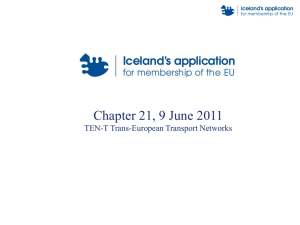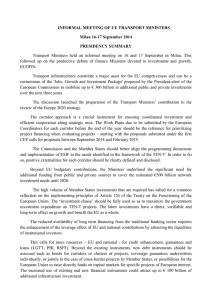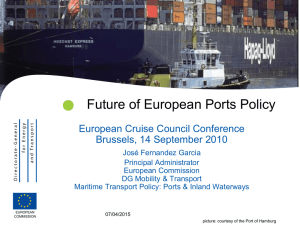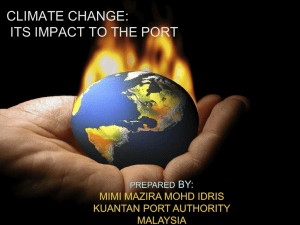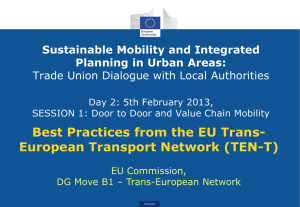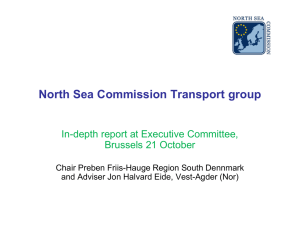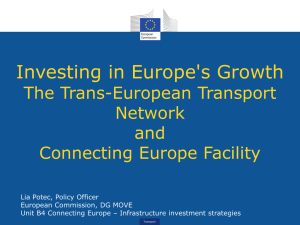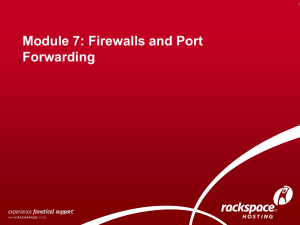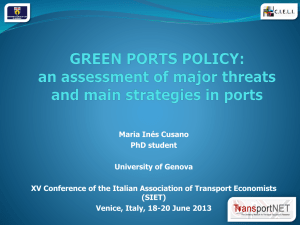TEN-T Comprehensive Network
advertisement
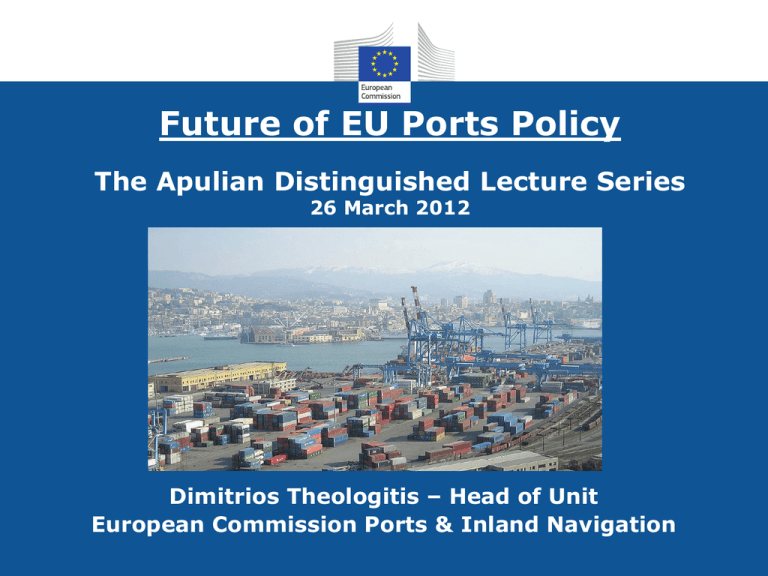
Future of EU Ports Policy The Apulian Distinguished Lecture Series 26 March 2012 Dimitrios Theologitis – Head of Unit European Commission Ports & Inland Navigation What do ports represent for the EU ? • Ports handle up to 90% of the EU external trade (in ton km) • Value of EU seaborne external trade: 1118,2 billion € (2009) • 40% of intra-EU freight exchanges (in tons) • Number of enterprises in ports: + 800 000 • Direct and indirect employment: +/- 3 million • More than 400 million passengers Issues of EU Ports • Lack of clear rules and transparency governing market access • Unsatisfactory legal framework in relation to social protection of workers (training, health and safety, stability of workforce) • Absence of minimum quality requirements for port service providers • Difficulty to monitor and measure performance of port services • Need for a level playing field and stability for investors and operators enabling further expansion of the port sector Reasons to act at EU level • EU 2020 & Growth prospects: shift in global economy, shift in EU economy, transformation of shipping logistics, new environmental and energy requirements: Engines for Growth • Every individual port included in the trans-European Transport Networks has significant cross-border effects and EU relevance • Port connections (sea-side, land-side) are a key factor for the smooth functioning of the internal and international market • To a large extent, quality, efficiency and reliability of ports determine the overall performance of the TEN-T A «three pillar» approach • Five years after the 2007 Communication on a European Ports Policy 1. TEN-T Guidelines and Connecting Europe Facility 2. Administrative Facilitation 3. Transparency and Regulated Market Access 1. Proposed Regulation on TEN-T guidelines (Oct 2011) • Double layer approach: • CORE network (hubs) + Multimodal Corridors • COMPREHENSIVE network (spokes) • Financing: • CEF: 32 billion € (including 10 billion € earmarked for Cohesion) • List of indicative projects (priorities) TEN-T metro map TEN-T Comprehensive Network • Relevance: • address the essence of maritime traffic (±340 ports covering >90% of total port volumes, plus regional ports) • an appropriate scale for future targeted transport policy measures • Stability: relative criteria vs. absolute values • Coherence: similar approach between ports and airports TEN-T Comprehensive Network (passengers) • Seaports connected to the land comprehensive network with a significant volume of traffic (>1‰ of EU maritime passenger traffic) • ± 400.000 pax / year according to EUROSTAT average yearly data for 2006/2007/2008 TEN-T Comprehensive Network (freight) • Seaports connected to the land comprehensive network with a significant volume (>1‰ of bulk and/or non-bulk EU cargo handling) • According to EUROSTAT average yearly data for 2006/2007/2008 TEN-T Comprehensive Network (accessibility and territorial cohesion) • Seaports not meeting the thresholds previously referred to • Island ports: Up to one port per NUTS 3 region • Peripheral or outermost regions: a distance of more than 200 km from another comprehensive port TEN-T Core Network (Criteria) 1. Seaports belonging to a primary city node (e.g.: Lisbon, Naples, Bordeaux) 2. Other seaports with annual throughput > 1 % of the EU total In principle 3. Access of NUTS 1 Region: the largest one per each NUTS 1 region with access to sea, for each continuous coastline TEN-T Core Network (multimodal) • Entry and exit points to the EU transport area of highest strategic importance (start & end of corridors) • Multimodal platforms (linked by more than 1 mode): • Rail • Road • Inland waterways & Inland Ports (where available) TEN-T Core Network (ITS) • ITS (Intelligent Transport System – in general) • • • • Enable traffic management Within and between transport modes For multimodal transport operations Facilitate seamless connections between EU, regional and local transport • ITS for ports, inland waterways and shipping • VTMIS • RIS • e-Maritime TEN-T Core Network (new technologies) • Enable decarbonisation • • • • Energy efficiency Alternative propulsion & infrastructure Safety and sustainability Resilience to climate change • Internalise external costs • Alternative clean fuels & technologies for ports: • Natural gas (cf Toolbox on LNG deployment) • Shore side electricity • S-scrubbers (and waste disposal) TEN-T: Motorways of the Sea (1) • The building block for the Maritime Dimension of TEN-T, covering the whole European Maritime Space • • • • • • Maritime links between ports (comprehensive and core) Port facilities ICT Safety and security Administrative and customs procedures Infrastructure for direct land and sea access • Leading to Safe, Secure and Sustainable Maritime Operations – instrumental to European Competitiveness TEN-T: Motorways of the Sea (2) • Examples: • • • • • Safety of Navigation Environmental performance of Ships and Ports (e.g. LNG), Traffic Management and Navigation Services (e.g. e-maritime) Optimised ship operations ICT for Ports and Logistics TEN-T: Motorways of the Sea (3) • Call 2012 – Possible topics: • • • • • • • • LNG Eco bonus Environmentally friendly ships Partnership with Neighbouring Countries Interoperability of ICT systems: e-maritime & beyond Safety & environmental protection in port areas Role of ultra-peripheral regions Training • For more information: • contact: Mr. Jose Laranjeira Anselmo (jose.anselmo@ec.europa.eu) TEN-T Inland Ports & Waterways • TEN-T Inland ports: located along TEN-T Inland Waterways (i.e.: Cat. IV or more): • • • • Annual freight transhipment volume exceeding 500 000 tonnes (three-year average - Eurostat) Connected with the road and/or rail infrastructure of the comprehensive network At least one freight terminal open to all operators in a nondiscriminatory way and apply transparent charges TEN-T Inland Waterways (Cat. IV or more): Core Network 2. Administrative Facilitation • European Maritime Transport Space without Barriers • Ongoing activity since 2009 • Actions in several fields: • Customs simplification for intra-EU traffic “Automatic” authorised operator Third country call • Phytosanitary and veterinary controls • Electronic transmission of documents – Reporting Formalities Directive, e-Maritime, Blue Belt, Blue Lanes Transparency and Regulated Market Access (1) • Transparency: • • • State-Aid Guidelines (DG COMP) Accounting Principles of port charging • Concessions (DG MARKT – December 2011) • • Horizontal issues (scope, …) Sector-specific (duration, renewal, investments, incumbents, transfer of assets and personnel) Transparency and Regulated Market Access (2) • Port Services • • • • • • • Pilotage Towage Mooring Dredging Icebreaking Environmental and Waste Services Passenger services Transparency and Regulated Market Access (3) • Principles (4+1) • • • • Safety & Security Training & Qualification Public Service Market Access +1: • Pricing • • • Cost – Efficiency Concertation! Proportional Non-discriminatory Transparency and Regulated Market Access (4) • Port Labour • Open access to the profession • Training and qualifications • Issues • Need for a strong and highly specialised labour force to tackle the expected growth and change of job profiles • Need to attract young professionals • Opening of the market • Detailed training and qualification profiles (ILO standards) • Safety considerations • Social standards – avoiding social dumping • Social dialogue • Dialogue between employers and employees 2012-2013: Consultation process • Full impact assessment: studies, research, evidence gathering • Bilateral discussions with Transport / National Port Authorities in the Member States and European Parliament • Dialogue with main European organisations (workers, port authorities, operators, providers and users of port services) • A conference on the future of EU ports (2012): presentation of interim conclusions and way forward • Not possible to prejudge the outcome at this stage, either as to the extent or as the form of any proposals (2013) • Thank you for your attention • dimitrios.theologitis@ec.europa.eu
